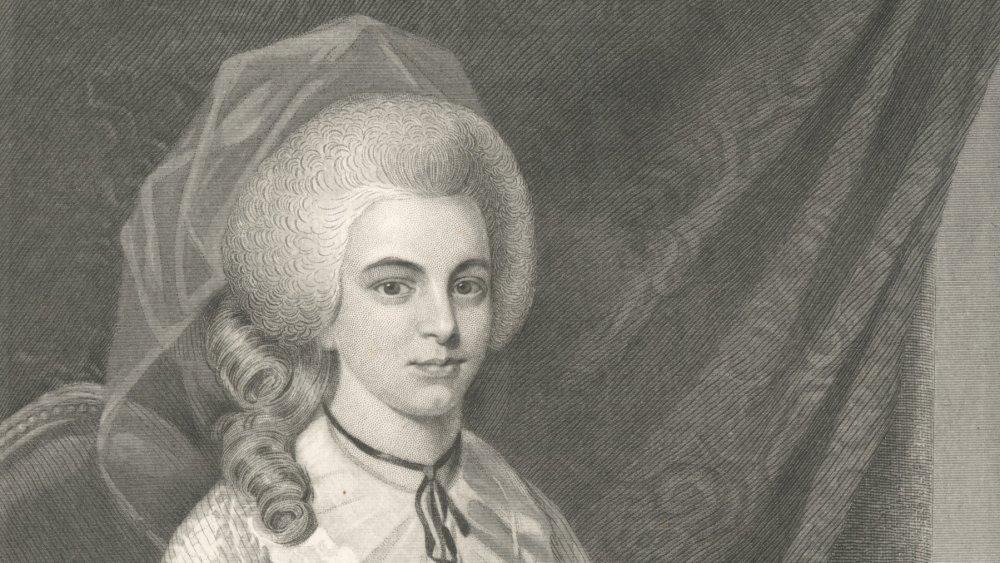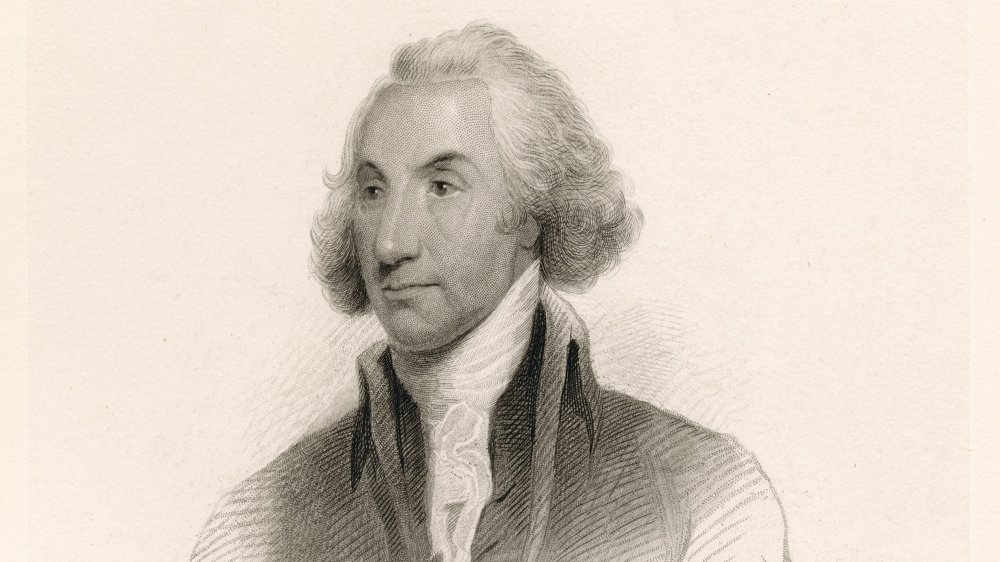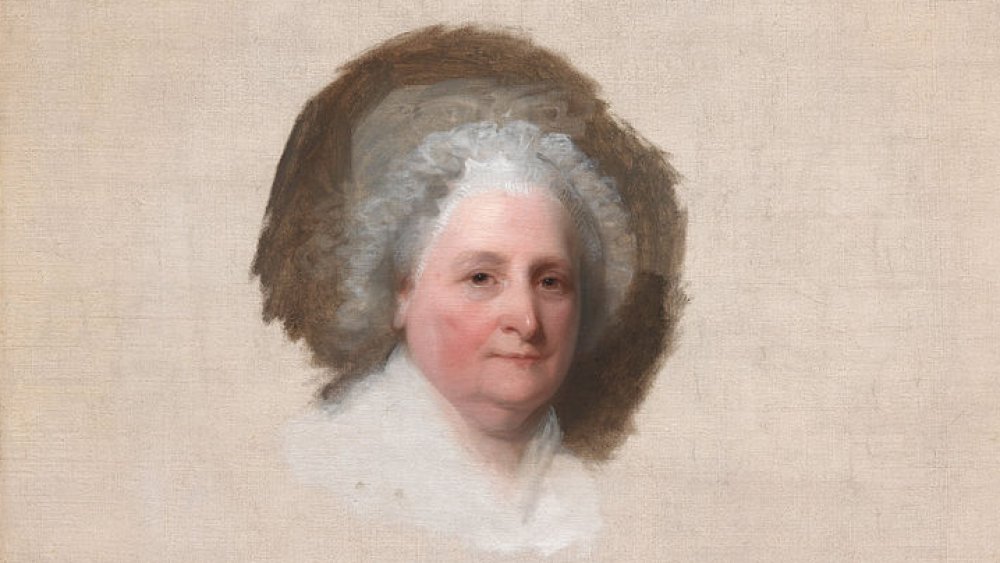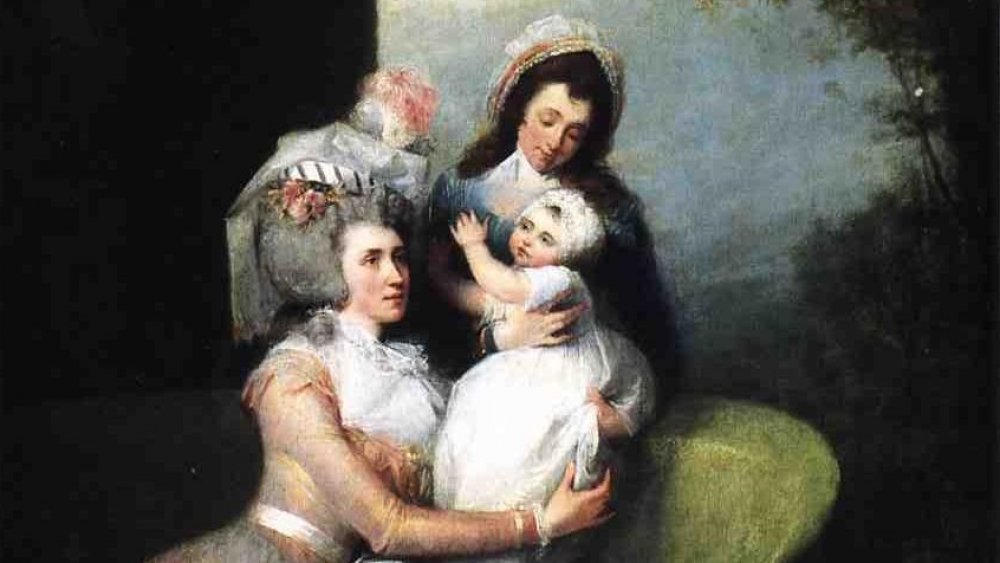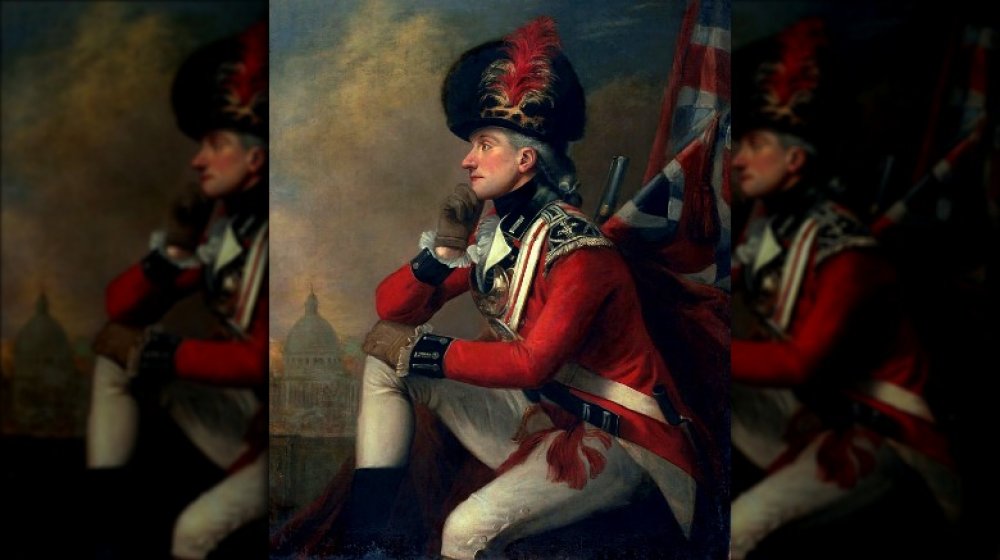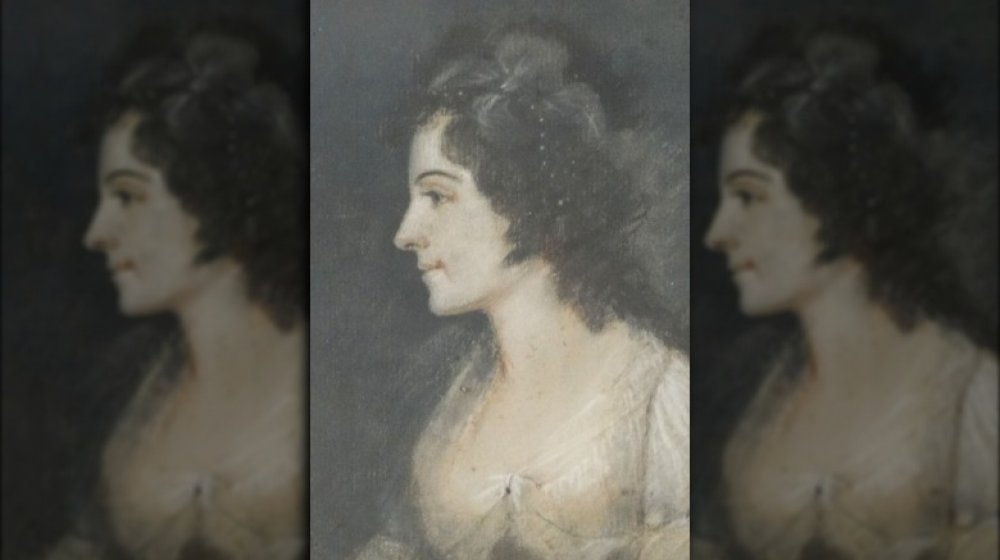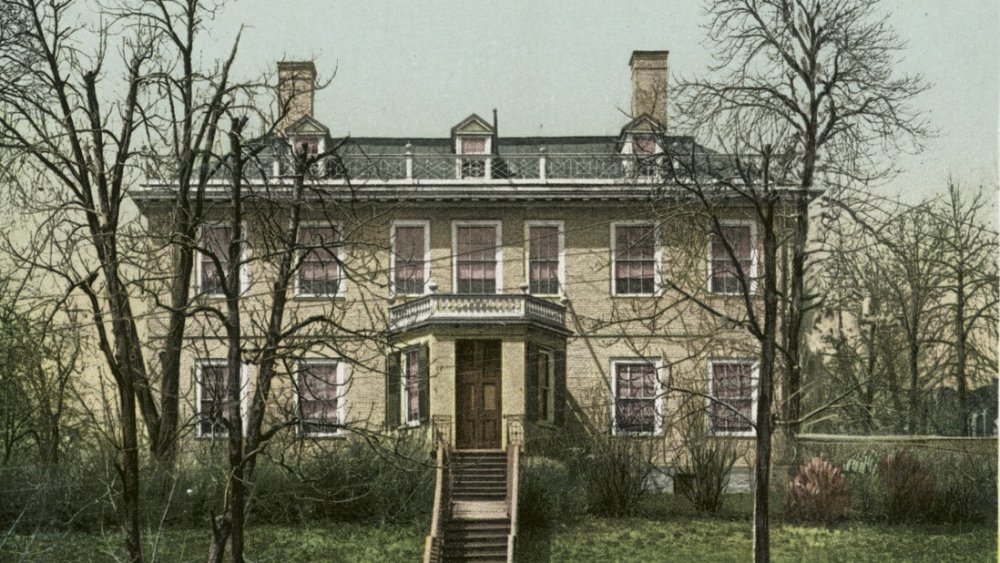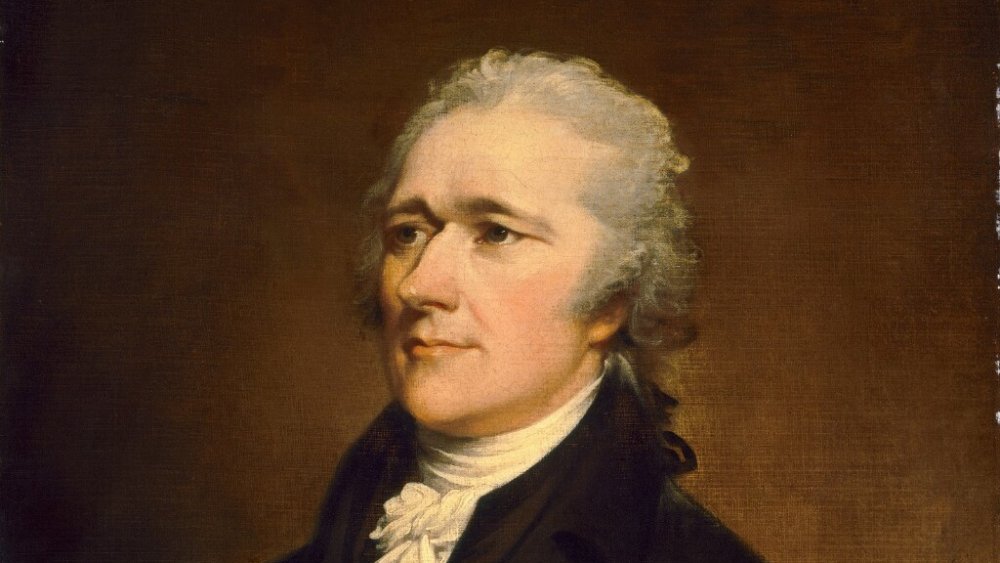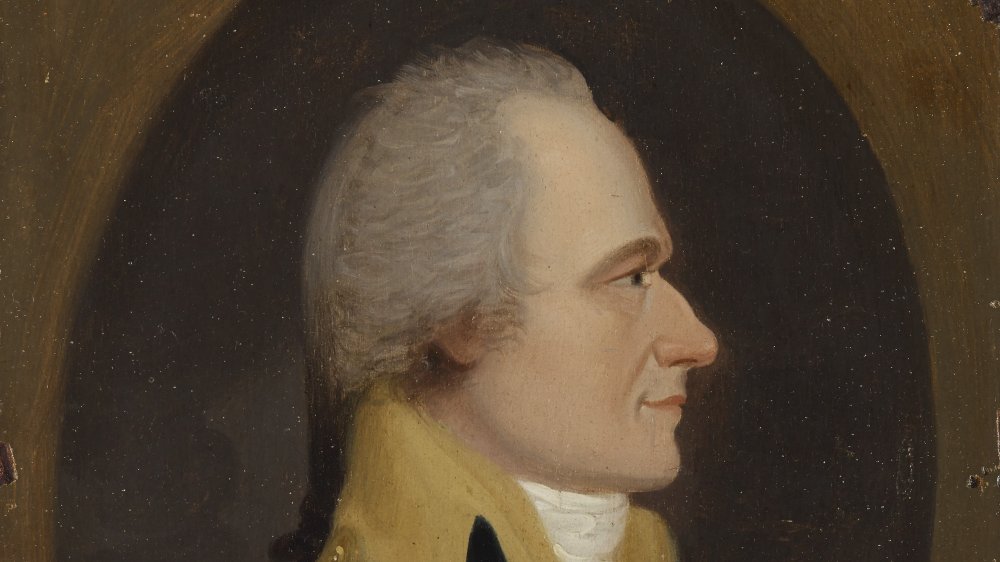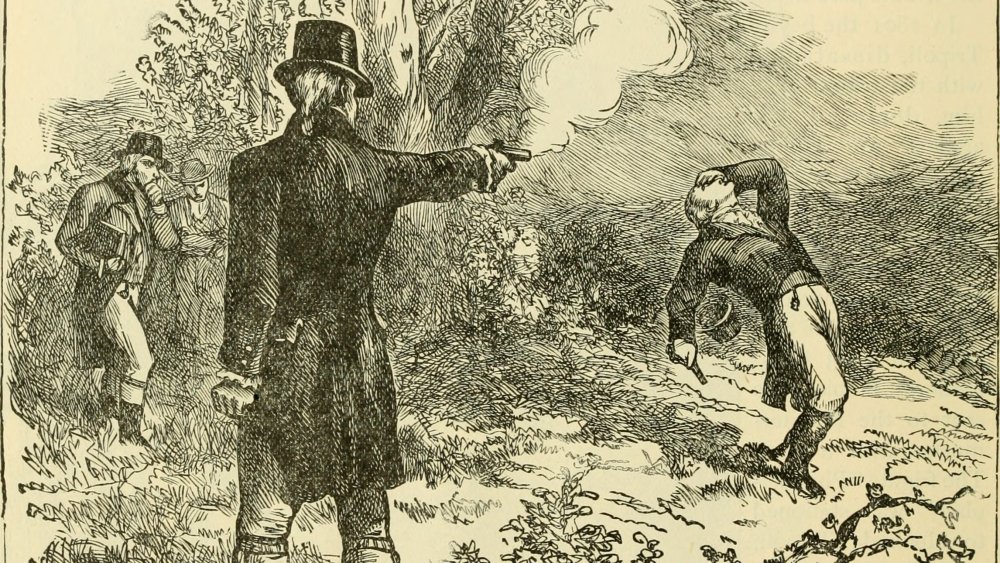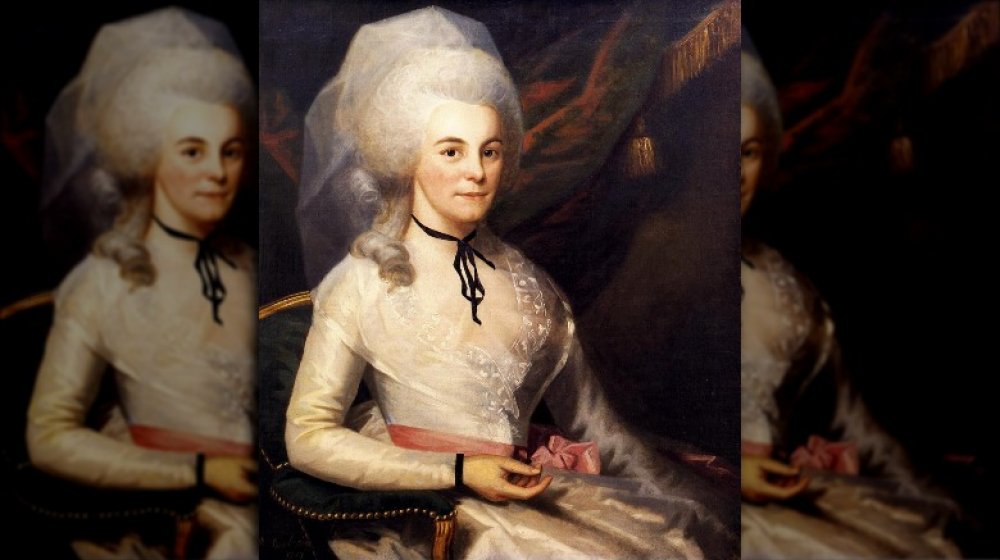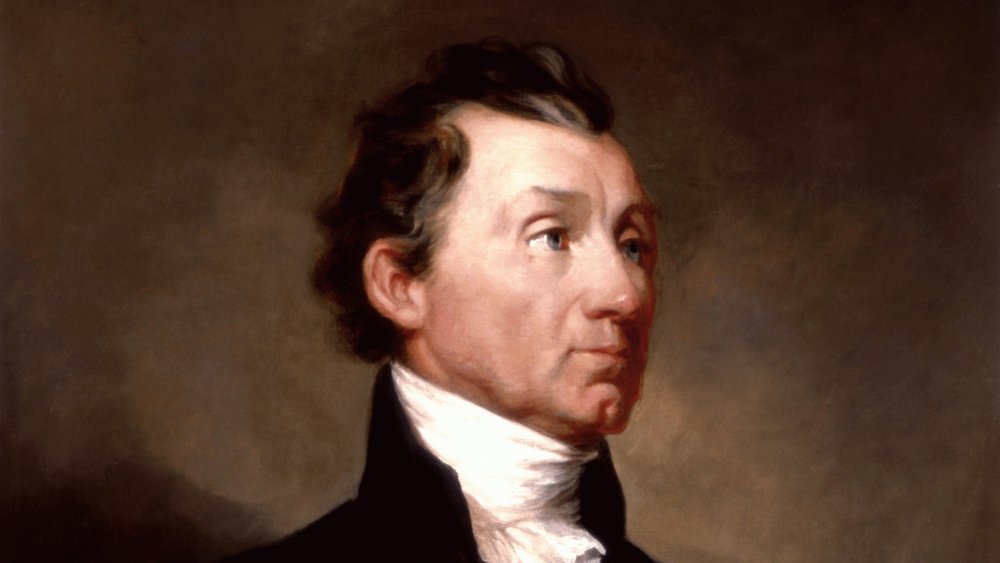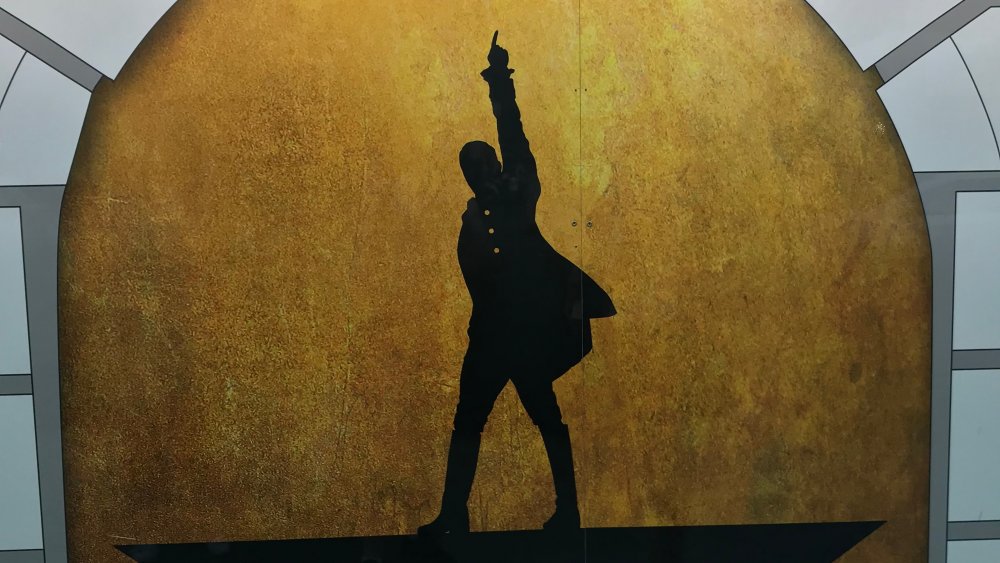What History Didn't Tell You About Elizabeth Schuyler Hamilton
Many of us are now very familiar with the musical Hamilton. According to the Chicago Tribune, the concept of a musical featuring the guy on the United States $10 bill was first received as a bit of a joke in 2008. Writer, singer, and actor Lin-Manuel Miranda didn't take it that way, though. He completed an early draft of the show in 2013, which finally debuted off-Broadway in 2015. A hugely successful Broadway run followed, along with a national tour, international shows, a performance at the White House for President Barack Obama, and a film version that premiered on Disney's streaming service in 2020.
The show obviously focuses on the exploits of Alexander Hamilton, said man on the $10 bill and, more importantly, a Founding Father and the nation's first treasury secretary. Yet, it also features a cast of important characters in Hamilton's life. For many first-time viewers, one particular role came as a bit of a surprise: Elizabeth Hamilton, Alexander Hamilton's faithful and long-suffering wife.
Once you dig into the story, however, Elizabeth Hamilton's prominence in the show may be less shocking than you think. She was not just an important part of her husband's story, but a vital historic figure herself. Elizabeth Hamilton was tied to the history of New York, had a front line role in the American Revolution, and spent the five decades after Alexander Hamilton's death securing his legacy and building her own as a beloved philanthropist. Thankfully, her own unique history is now coming to light.
Elizabeth Schuyler Hamilton came from seriously old money
Elizabeth Schuyler was born with a serious boost in life. According to the Times Union, her father was Gen. Philip Schuyler, son of a prosperous Dutch family and a key figure in the American Revolution. Schuyler advised George Washington himself, who was known to have stayed at the Schuyler mansion in Albany, N.Y.
Elizabeth Schuyler's mother, Kitty, wasn't exactly a commoner, either. Born Catherine Van Rensselaer, she was already well-situated in New York society thanks to her ties to the original Dutch founders of New Amsterdam, ThoughtCo reports. The Van Rensselaer family was one of the biggest names in town, at one time managing an estate of a staggering estimated 1 million acres. Kitty, then, was widely acknowledged as a genteel lady with fine manners who was a good match for her well-educated, politically connected husband. Their children, including young Elizabeth, were similarly schooled and set up to succeed in the social and political world of the new nation founded in the wake of the American Revolution.
Elizabeth Hamilton was best buds with Martha Washington
Elizabeth Hamilton met the older Martha Washington at Morristown, N.J. in the winter of 1787, says the biography Alexander Hamilton, written by Ron Chernow. She wrote that, though Washington was by then 50 years old, had a bit of gray in her hair, and was a little plump, she "was still handsome .... She was always my ideal of a true woman." Hamilton was evidently impressed by Washington's warm demeanor, her down-to-earth sensibilities, good taste, and connections to budding American history.
Both Hamilton and Washington exchanged gifts that evening, with Hamilton giving the older woman a pair of cuffs and Washington gifting the younger a bit of powder. The two got along so well that they formed a lifelong friendship akin to a mother-daughter bond. The Washington Library includes a letter written from Washington to Hamilton in 1793. At that time, Alexander Hamilton was ill with yellow fever. Washington wrote that she prayed for his recovery, and that Elizabeth Hamilton should be careful with her own health, so she can continue to support her growing family.
Elizabeth Schuyler Hamilton was a dutiful daughter with slightly scandalous sisters
Much of the historical record concerning Elizabeth Hamilton paints her as a dutiful daughter, more apt to follow the social rules of her time when it came to love, even though she was involved with a young hotshot known as Alexander Hamilton. At least, that's how it was compared to the exploits of her sisters Angelica and Peggy.
According to ThoughtCo, Angelica, the eldest child of the Schuylers, became involved with John Barker Church, a British member of Parliament who had essentially torched his reputation back home by selling goods to the revolutionary Continental Army. Though the U.S. Treasury paid him back for his work with a 100,000-acre plot of land in New York, his character might have still been in question after the war. That may be why Angelica eloped with him in 1777. Things worked out, though, and Angelica spent much of her remaining life moving in high society and political circles alongside her husband. Also, though she frequently wrote to her brother-in-law, Alexander, there's no evidence that she harbored secret feelings towards Elizabeth's husband.
Margarita, the third Schuyler child who is better known as "Peggy," may have been inspired by Angelica, when she also eloped years later. In 1783, she married her distant cousin, the teenaged Stephen Van Rensselaer III. In the aftermath, both families expressed approval. Peggy was also familiar with Alexander, who was at her bedside when she died in 1801.
Young Elizabeth Hamilton might have had a crush on a British spy
Though speculative, the possible juvenile feelings Elizabeth Schuyler Hamilton might have had for a British officer and future prisoner of war could have complicated her budding relationship with Alexander Hamilton. The fact that the officer in question was the dashing John André, future head of the British Secret Service, didn't help, either.
André had stayed at the Schuyler mansion in 1775, when Elizabeth would have been a teenager, ThoughtCo says. While there, the artistically-inclined André sketched for Elizabeth, forming a friendship between the two. Nothing seems to have developed from there, but something of that friendship remained even when André was captured as a spy in 1780. Elizabeth wrote to her fiance, Alexander, hoping that he could use some of his own political influence to at least allow André to die by firing squad, rather than by hanging. Alexander failed and Elizabeth refused to write back to him for weeks.
Alexander Hamilton was clearly jealous of André. In a letter to Elizabeth Hamilton included in the National Archives, he bemoaned the idea that he didn't measure up. "I know I have talents and a good heart; but why am I not handsome?" he wrote, maybe thinking then of the good-looking André. Perhaps the idea that his captivating fiancee might have held some attraction for André, even if it was only an innocent teenage crush, was a bit too much for Alexander's insecurities in this moment.
Alexander Hamilton was captivated by the young Elizabeth Schuyler
Elizabeth Schuyler Hamilton was, by many accounts, a striking young woman. Alexander Hamilton, young aide to George Washington, certainly seemed to think so, if his besotted letters to Elizabeth are any indication. In one, included in the biography Alexander Hamilton, he told her younger sister Peggy that Elizabeth was "most unmercifully handsome .... she possesses all the beauties, virtues, and graces of her sex without any of those amiable defects which are esteemed by connoisseurs necessary shades in the character of a fine woman." Elizabeth was, apparently, not like other girls.
Though Alexander Hamilton was very taken by Elizabeth's good nature and sensible manner, he was also quite taken by her looks. According to PBS, he did admit to a friend that she wasn't the most beautiful woman in the world, but that she did have captivating dark eyes. "I meet you in every dream," he once wrote to her, in words that could make many a modern woman swoon, too. It definitely worked for Elizabeth, who took part in a whirlwind courtship that culminated in her Dec. 14, 1780, marriage to Alexander at the Schuyler mansion.
Elizabeth Hamilton dealt with war and separation while pregnant
After their marriage, Alexander Hamilton spent much of his time helping Gen. George Washington. The newlywed Elizabeth Hamilton lived with her father in New York. Like so many freshly married women of the era, she soon found that she was pregnant. According to Alexander Hamilton, the area around Albany, where Elizabeth and her family were staying, had become rather tumultuous. Her father, Gen. Philip Schuyler, wrote that the region was "one general scene of ruin and desolation," with bloody raids conducted by the British and their white and Native American allies.
Some of that danger came up the family's doorstep and straight into the Schuyler home. On Aug. 7, 1781, a group of about 20 Tories and Native people forced their way into the mansion, seemingly with the intent to harm Schuyler and his family. As per Alexander Hamilton, sisters Angelica and Elizabeth, both pregnant, fled to an upper room with the rest of their family. Schuyler fired a pistol out of the window to call for help. Peggy, however, realizing that her infant sister was still in a cradle downstairs, left her hiding family and went to retrieve the baby. She bluffed her way through a confrontation with the home invaders, the story goes, telling them that her father had actually gone to town and was going to return with troops. The group fled and, thanks in part to Peggy, Elizabeth and the rest of her family were safe for the time being.
Elizabeth Hamilton left Alexander Hamilton while six months pregnant
For much of her marriage to Alexander Hamilton, Elizabeth Hamilton would often be pregnant and saddled with the responsibility of tending to her growing brood of children. According to Alexander Hamilton, the pair had a total of eight children over the course of their marriage. Some speculate that this responsibility may have somehow encouraged Alexander to stray into an extramarital affair, though one wonders if that should really be Elizabeth's fault when she was apparently only trying to raise a family.
Busy as she may have been, as the years went on, it grew more and more difficult for Elizabeth to deny that her husband had been unfaithful. As ThoughtCo reports, the 1797 publication of the infamous Reynolds Pamphlet finally broke the spell. Alexander, who had been accused of having an affair with Maria Reynolds and then using federal funds to pay off her husband, wrote the pamphlet in an attempt to vindicate himself. Though he was found innocent of using government money in the affair, his actions tore apart his marriage. Ultimately, Elizabeth, who was pregnant with the couple's sixth child, left for her family home in Albany. The two eventually reconciled and even had two more children, but the events must have remained fresh in Elizabeth's memory for many years to come.
Alexander Hamilton left Elizabeth Hamilton with significant debts after he died
Though Elizabeth Hamilton lived relatively comfortably with her husband for much of her married life, she was hit with harsh reality shortly after Alexander Hamilton's 1804 death from a duel. The New Netherland Institute reports that Elizabeth soon realized that her husband had left behind some pretty significant debts. His widow, however much she was grieving, was obliged to pay out.
This presented a real problem for Elizabeth. Women generally didn't have much of an avenue to make their own money in the 18th century United States. She also had to consider how she was going to keep herself and her seven surviving children afloat. She decided to sell her 35-acre estate in Manhattan. Thankfully, she was able to buy it back at a discount, because executors realized that it would be a pretty bad look if they left Alexander Hamilton's widow and children destitute. According to PBS, she was also buoyed by a relatively modest inheritance from her father Philip Schuyler's estate after his passing, as well as donations from Alexander's friends. Elizabeth then sold the estate yet again and bought a townhome that would be hers for the next nine years, along with the families of two of her children.
The years surrounding 1804 were especially difficult for Elizabeth Hamilton
For fans of the Hamilton musical, the next tragedy may loom the largest in the story. In 1804, tensions between Alexander Hamilton and his longtime rival, Aaron Burr, finally reached a head, according to History. The two agreed to a duel in July 1804, resulting in Hamilton's death when a bullet lodged in his abdomen. Burr, who was then serving as vice president to President Thomas Jefferson, was charged with murder but never prosecuted because of his position.
It wasn't over yet, says Smithsonian Magazine. In November 1804, Gen. Philip Schuyler died, leaving Elizabeth Hamilton without both of her parents. Her oldest daughter, Angelica, suffered a nervous breakdown after her brother Philip's death. According to Alexander Hamilton, Angelica's mental break was so intense that she went through the rest of her life in an "eternal childhood," frequently unable to care for herself or recognize her own family members.
With much of her support structure now demolished, Elizabeth had to figure out how to keep her family afloat. Though other women might have remarried in time, that was never an option for Elizabeth, who remained single for the five decades of her life that followed Alexander's death.
The orphanage Elizabeth Hamilton founded is still operating today
In her long widowhood, Elizabeth Hamilton became a well-known public figure and an active philanthropist. Much of her work seems to have had a tie to her late husband, who had been orphaned early in his life.
According to History, one of her charitable moves was to help establish the Hamilton Free School in Manhattan, N.Y. Along with some of her society friends, Hamilton asked the New York State Legislature to allow for a free school and give them some annual funding. They got both and opened the school in 1818. The students did not have to pay tuition and were provided with textbooks, though the school's single teacher also had to do double-duty as the janitor.
Hamilton also helped to found the first private orphanage in the city in 1806, says the National Museum of American History. First known as the Orphan Asylum Society, it was founded by Hamilton, along with Isabella Graham, Joanna Bethune, and Sarah Hoffman. Hamilton worked as its director until 1848. Though the Hamilton Free School was eventually overtaken by public schools, the Orphan Asylum Society lives on today. It's now known as Graham Windham, a social services organization. In 2015, it teamed up with Phillipa Soo, who played Elizabeth Hamilton in the Hamilton musical, to create The Eliza Project, which provides artistic instruction and programming for the children served by Graham Windham.
Elizabeth Hamilton really had it in for James Monroe
In her old age, Elizabeth Hamilton was pretty genial towards all, with one notable exception: James Monroe. It didn't matter that Monroe eventually served as President of the United States, or that he tried on multiple occasions to bury the hatchet with her. For some people, Hamilton simply could not break a grudge.
To her mind, James Monroe had committed a pretty serious infraction against the Hamilton family. According to The Washington Post, she believed that Monroe was the one who leaked the information that led to the Reynolds affair, which involved accusations that Alexander Hamilton had played fast and loose with the new nation's money. The resulting scandal ruined Alexander's political career and put a considerable dent in the Hamilton marriage. That's enough for anyone to nurture a grievance, even if Elizabeth lived to the ripe old age of 97 while doing so.
Monroe tried to patch things up, but to no avail. Smithsonian Magazine reports that he once called upon the widow Hamilton to make nice, but she refused to even offer him a seat. Monroe was forced to speak to her while awkwardly standing in the middle of her sitting. According to her nephew, once Monroe had finished talking, Elizabeth told him that "No lapse of time, no nearness to the grave, makes any difference." The former president left, presumably at least a bit humiliated, without ever patching things up with the still fiery Elizabeth.
There's no musical without Elizabeth Hamilton
In between raising her children and becoming a New York City philanthropist, Elizabeth Hamilton had another mission. She dedicated much of her remaining years to preserving the history of her husband — putting so much effort into the venture that we have her to thank for the mega-hit Hamilton musical.
Elizabeth proved to be a passionate defender of Alexander Hamilton's legacy. According to Smithsonian Magazine, she maintained that he was the primary author of George Washington's Farewell Address, rather than James Madison. In an effort to maintain that legacy, she went on an extended research mission, collecting his papers, writing to his colleagues, and enlisting her son, John Church Hamilton, to act as editor.
Her work was so valuable that journalist and historian Ron Chernow, who wrote the biography Alexander Hamilton, says that it would have been far more difficult to complete his work without her efforts. After Alexander Hamilton's death, his political enemies were in power and would likely have been happy to see his legacy fade into obscurity. With Elizabeth standing in the breach, however, that was never going to happen. Thanks to her work, we have not only Chernow's biography but the musical it inspired, the ever-popular Hamilton. As Playbill reports, writer and star Lin-Manuel Miranda worked closely with Chernow to adapt his work for the stage. In many ways, they both have Elizabeth to thank for their success.
